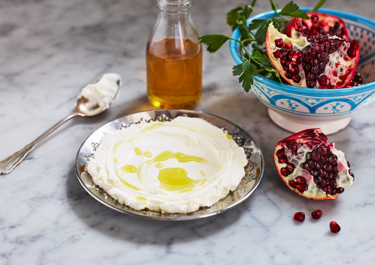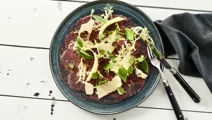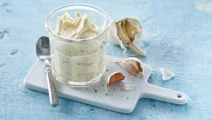Labneh

Labneh is a type of Middle Eastern cheese that is made by straining yoghurt until it reaches a thick and creamy consistency. It has a tangy and slightly salty flavour, making it a versatile ingredient that is becoming increasingly popular in Western cuisine. With our quick recipe, making it at home is simple and requires only a few ingredients. Try using it as a dip, spread, or salad dressing to add some Middle Eastern flavours to your meals. Whether you are looking to add some Middle Eastern flair to your cooking or simply want to try something new and delicious, this homemade labneh is sure to impress.
Ingredients
|
1 l
Whole milk yoghurt, naturel or Greek inspired yoghurt, 10%
|
|
|---|---|
|
1 tsp
Salt
|
|
|
2 tbsp
Olive oil
|
Instructions
Recipe tips
It’s often the small details that make the biggest impact in the kitchen, so we’re sharing the tips we rely on when cooking and creating recipes
You can preserve it in olive oil for months. This preservation method, however, requires a thicker labneh and is, as such, more time-consuming as it needs to strain for 48 hours as opposed to just 24 hours. The longer straining times give it a thicker texture that allows you to fashion it into small balls (about 2 cm in diameter). Chill these balls overnight before completely submerging them in high-quality olive oil in a clean mason jar.
Questions about labneh
With a simple labneh recipe like ours, making this versatile Middle Eastern staple is wonderfully easy. To learn more about it, read our answers to the most frequently asked questions about it below.
What is labneh?
Labneh is a Middle Eastern soft cheese made from strained yoghurt. It is popular in Lebanese and other Middle Eastern cuisines. The process involves straining goat or cow milk yoghurt until it becomes thick and creamy with a texture like that of cream cheese. The flavour is tangy, salty, and slightly sour, with a rich mouthfeel. It can be served as a dip or spread, often drizzled with olive oil and sprinkled or flavoured with spices, such as za'atar, sumac, and dukkah.
How to make labneh?
Though it requires a bit of planning ahead, making a homemade labneh is incredibly easy, almost entirely hands-off, and requires just two ingredients – whole milk yoghurt and salt. Simply mix your yoghurt of choice with salt and pour it into coffee filters placed in a sieve. Then, place it in the fridge and give it time to strain through the coffee filters and into the bowl waiting under the sieve. Straining it this way gives it the deliciously thick, rich, and creamy texture for which it is known.
How to eat labneh?
You can enjoy it as a dip with fresh vegetables and warm bread or as a creamy spread in sandwiches. It may also be used as a substitute for sour cream or cream cheese in various recipes. It is a flavourful ingredient that has become popular in many parts of the world due to its delicious taste and texture. Serving it with different labneh toppings like drizzled olive oil, spices, fresh herbs, olives, or even jewel-like pomegranate seeds makes it look wonderfully enticing.
How long does labneh last in the refrigerator?
Homemade labneh typically keeps for 10-14 days. It is important to store it in an airtight container to prevent air exposure, which can cause it to dry out and become less flavourful. Additionally, it is recommended to store it towards the back of the fridge, where the temperature is often more consistent and cooler. If you notice any signs of spoilage, such as mould, an off smell, or changes in texture, discard it immediately. To extend its shelf life, you can also add a layer of olive oil on top. This can help to preserve its flavour and freshness.
Can you freeze labneh?
Yes, you can freeze labneh for up to 1 month. However, while the flavour is the same, it might change the consistency slightly, making it more grainy after thawing, but if you are using it as a spread or in cooked dishes, it does not matter if the texture is a bit grainy. To freeze it, simply transfer it to an airtight container, cover the surface with olive oil, and wrap the container in cling film. When you are ready to use it, allow it to thaw in the fridge overnight. Give it a good stir before serving to help restore some of its original texture.
Homemade labneh made from yoghurt
Labneh has a tangy and slightly sour flavour that is similar to cream cheese but has a distinct Middle Eastern twist. It is a versatile ingredient that can be used as a spread or dip and pairs well with a range of flavours, such as herbs, spices, and olive oil.
One of the benefits of making it at home is that you can customise the flavour to your liking. For example, you can add garlic, lemon juice, or other seasonings and spices to the yoghurt before straining it to create a unique flavour profile.
Creamy, thick, and tangy yoghurt cheese
Labneh is a type of Middle Eastern fresh cheese that is made by straining either goat or cow whole milk yoghurt until it gains a thick and creamy consistency. The yoghurt is mixed with salt and left to strain for several hours, which removes the whey (the liquid component of milk) and results in a rich and tangy flavour.
Its texture is smooth and creamy, with a spreadable consistency similar to cream cheese. It has a distinct sour and salty taste, with hints of tanginess that make it a popular savoury ingredient in dips, spreads, and dressings.
Delicious uses for labneh
The tangy flavour and creamy consistency of labneh make it great for a vast array of different dishes. It can be enjoyed on its own or served as a base for various toppings, such as olive oil, herbs, and spices.
As a dip, it tastes great with crunchy vegetables like sweet carrots, peppery radishes, and mild cucumber sticks. If you want to make an even heartier snack for your meze table, you can serve it with homemade flatbread or pita bread for dipping. You can also use it as a spread in sandwiches and on bagels, just like you would cream cheese.
Throughout the Middle East, this tasty dip is also enjoyed at breakfast, for instance, with pancakes. Try serving fluffy American pancakes topped with labneh, honey, and either fresh or dried berries for a breakfast or brunch dish that is sweet, savoury, and scrumptious.
Make spiced labneh with dukkah, za'atar, garlic, harissa, or other flavours
Experimenting with different kinds of flavours is as fun as it is tasty! Some popular choices include serving labneh with za'atar or other spices either mixed into the pre-strained yoghurt or sprinkled on top as a decorative seasoning. Za'atar is a Levantine spice blend with salt, sesame seeds, and dried herbs like sumac, oregano, basil, and thyme. Za'atar is full of nutty, lemony, and herbaceous flavours and, as such, makes for an incredibly aromatic seasoning.
If you enjoy bold flavours, you might also like to try an aromatic, slightly sharp garlic labneh dip. If nutty flavours are more up your alley, dukkah is a perfect choice, and you can use our dukkah recipe to make the Middle Eastern spice blend yourself.
If you want to experiment with colour as well as flavour, you can use beetroot to give it a vibrant pink colour and a sweet, earthy flavour, or Middle Eastern chilli paste to make a spicy, red harissa labneh dip flavoured with the paste's roasted red peppers, cumin, coriander, and caraway seeds.








